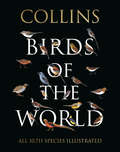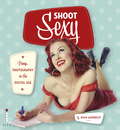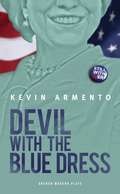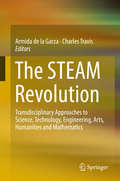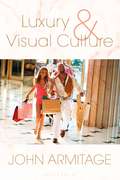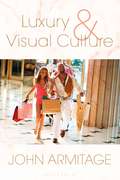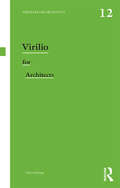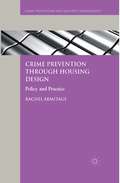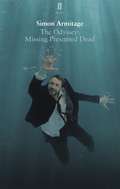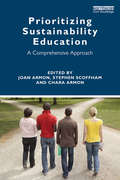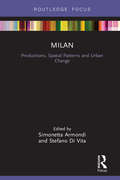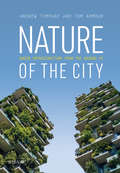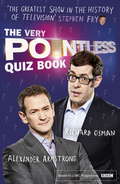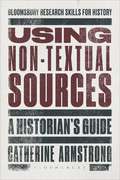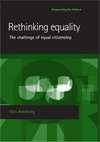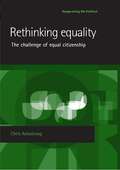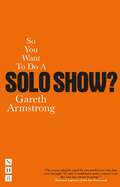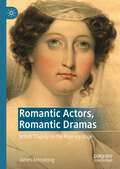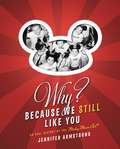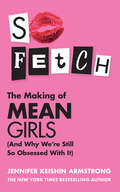- Table View
- List View
Collins Birds of the World
by Norman Arlott Ber van Perlo Jorge R. Mata Gustavo Carrizo Aldo A. Chiappe Luis HuberFor the first time, the complete collection of the Collins Field Guides’ incredibly detailed, accurate and beautiful bird paintings has been brought together in one comprehensive volume.
Shoot Sexy: Pinup Photography in the Digital Age
by Ryan ArmbrustThe pinup look made famous on WWII bombers and in the 1950s has become a timeless classic that is now undergoing a revival through digital photography. Alongside the rapid growth of the Boudoir genre - also covered in this book - the retro pinup look is an increasingly popular request from clients. This book will show you all how to achieve it, whether you're shooting professionally, or just for fun.
Devil with the Blue Dress (Oberon Modern Plays)
by Kevin ArmentoThis gets called the Monica Lewinsky Scandal. You made sure everyone knew my name. January 1998: America is rocked by one of the biggest political sex scandals of all time. Slyly exhuming the little blue dress that launched the biggest media circus of a generation, the five women who were at the centre of the infamous Monica Lewinsky scandal collide on stage in this political thriller. A First Lady, a secretary, a daughter, a confidant, and an intern take us through the corridors of power and behind the closed doors where the abuse of that power took place. A theatrical battle over exactly how it all went down, DEVIL WITH THE BLUE DRESS asks who were the heroes and villains, and why, twenty years later, we’re only beginning to grapple with one of the most challenging questions in American political history: How do we respond to women seeking power, and the men who misuse it?
The STEAM Revolution: Transdisciplinary Approaches to Science, Technology, Engineering, Arts, Humanities and Mathematics
by Armida de la Garza Charles TravisThis volume is dedicated to collaborative research across STEM disciplines, the arts and humanities. It includes six sections, framed from a global perspective and exhibits contributions from key experts in the field, emerging scholarly voices, and STEAM practitioners. The added value of STEAM projects in research is highlighted in the first section of this book. Ranging from the spatial, medical and environmental humanities to heritage science, this section discusses the course and paths STEAM projects may evolve to in the near future. The second section features reflective essays by scientists and artists on the development of their research, their professional growth and personal learning experiences that the art/science collaborations have afforded their work and careers. Sections III and IV provides practical guidance and advice on facilitating STEAM teams and describe successful collaborative projects. By presenting the objectives and outcomes of relevant research, the chapters in these sections discuss the various steps taken by different teams to achieve project fruition. Paying particular attention to barriers inhibiting STEAM collaboration, these sections also explore the ways in which research teams were able to work effectively. The fifth section presents a review of policy issues and the potential impacts of STEAM research for administrators, funders and policy makers. In its pursuit for balance and inclusion, the volume concludes with a critical reflection on STEAM that argues a different perspective and will prove food for thought to readers.
Luxury and Visual Culture
by John ArmitageFrom couture fashion to opulent perfumes and decadent food, the luxury goods and services industry has grown at an unprecedented rate even in the context of a global recession. But in contemporary digital culture does luxury still reside in material things, or rather the look of things? In this first study of luxury through the lens of visual culture, Armitage argues that luxury is undergoing a shift from material culture to the immaterial culture of the visual, offering new forms of luxury engagement and unparalleled levels of pleasure never before offered to the senses.Calling for a new understanding of luxury in the changing visual landscape of contemporary society, Luxury and Visual Culture embraces an extraordinary range of cultural forms, including fashion, photography, social media, television, and art. From the masterpieces of Damien Hirst and Jeff Koons, to Richard Avedon's photography and Louis Vuitton's Flagship stores, the book explores key issues of globalization, digitization, consumer identity, “mass” luxury, and the role of art. This text is ideal for all students of contemporary luxury studies, as well as scholars and researchers in the field of visual culture.
Luxury and Visual Culture
by John ArmitageFrom couture fashion to opulent perfumes and decadent food, the luxury goods and services industry has grown at an unprecedented rate even in the context of a global recession. But in contemporary digital culture does luxury still reside in material things, or rather the look of things? In this first study of luxury through the lens of visual culture, Armitage argues that luxury is undergoing a shift from material culture to the immaterial culture of the visual, offering new forms of luxury engagement and unparalleled levels of pleasure never before offered to the senses.Calling for a new understanding of luxury in the changing visual landscape of contemporary society, Luxury and Visual Culture embraces an extraordinary range of cultural forms, including fashion, photography, social media, television, and art. From the masterpieces of Damien Hirst and Jeff Koons, to Richard Avedon's photography and Louis Vuitton's Flagship stores, the book explores key issues of globalization, digitization, consumer identity, “mass” luxury, and the role of art. This text is ideal for all students of contemporary luxury studies, as well as scholars and researchers in the field of visual culture.
Virilio for Architects (Thinkers for Architects)
by John ArmitagePaul Virilio is an innovative figure in the study of architecture, space, and the city. Virilio for Architects primes readers for their first encounter with his crucial texts on some of the vital theoretical debates of the twenty-first century, including: Oblique Architecture and Bunker Archeology Critical Space and the Overexposed City The Ultracity and Very High Buildings Grey Ecology and Global Hypermovement In exploring Virilio’s most important architectural ideas and their impact, John Armitage traces his engagement with other key architectural and scientific thinkers such as Claude Parent, Benoit B. Mandelbrot, and Bernard Tschumi. Virilio for Architects allows students, researchers, and non-academic readers to connect with Virilio’s distinctive architectural theories, critical studies, and fresh ideas.
Virilio for Architects (Thinkers for Architects)
by John ArmitagePaul Virilio is an innovative figure in the study of architecture, space, and the city. Virilio for Architects primes readers for their first encounter with his crucial texts on some of the vital theoretical debates of the twenty-first century, including: Oblique Architecture and Bunker Archeology Critical Space and the Overexposed City The Ultracity and Very High Buildings Grey Ecology and Global Hypermovement In exploring Virilio’s most important architectural ideas and their impact, John Armitage traces his engagement with other key architectural and scientific thinkers such as Claude Parent, Benoit B. Mandelbrot, and Bernard Tschumi. Virilio for Architects allows students, researchers, and non-academic readers to connect with Virilio’s distinctive architectural theories, critical studies, and fresh ideas.
Crime Prevention through Housing Design: Policy and Practice (Crime Prevention and Security Management)
by R. ArmitageThis book presents a comprehensive review of the impact of residential design on crime focusing upon research, policy and practice both in the UK and internationally, appealing to both academics and practitioners within the fields of crime prevention, urban planning and architecture.
The Odyssey: Adapted for the Stage
by Simon ArmitageA high-ranking government minister with a colourful past is sent on a diplomatic mission to Istanbul. When his trip ends up in a bar-room brawl, he becomes Europe's most wanted man overnight. Chased by the authorities, damned by religious leaders, pursued by those looking for vengeance and head-hunted by fanatics, his odyssey begins. Plunged into the ancient past, Odysseus must now contend with all the unworldly beings and unnatural phenomena that stand in his way. The Cyclops, the Sirens, witches, whirlpools and flesh-eating armies must all be overcome in the struggle for survival and the long voyage back home.Simon Armitage's The Odyssey: Missing Presumed Dead premiered at the Liverpool Everyman in September 2015 then toured the UK in a co-production with English Touring Theatre.
Prioritizing Sustainability Education: A Comprehensive Approach
by Joan Armon Stephen Scoffham Chara ArmonPrioritizing Sustainability Education presents theory-to-practice essays and case studies by educators from six countries who elucidate dynamic approaches to sustainability education. Too often, students graduate with exploitative, consumer-driven orientations toward ecosystems and are unprepared to confront the urgent challenges presented by environmental degradation. Educators are prioritizing sustainability-oriented courses and programs that cultivate students’ knowledge, skills, and values and contextualize them within relational connections to local and global ecosystems. Little has yet been written, however, about the comprehensive sustainability education that educators are currently designing and implementing, often across or at the edges of disciplinary boundaries. The approaches described in this book expand beyond conventional emphases on developing students’ attitudes, knowledge, and behaviors by thinking and talking about ecosystems to additionally engaging students with ecosystems in sensory, affective, psychological, and cognitive dimensions, as well as imaginative, spiritual, or existential dimensions that guide environmental care and regeneration. This book supports educators and graduate and upper-level undergraduate students in the humanities, social sciences, environmental studies, environmental sciences, and professional programs in considering how to reorient their fields toward relational sustainability perspectives and practices.
Prioritizing Sustainability Education: A Comprehensive Approach
by Joan Armon Stephen Scoffham Chara ArmonPrioritizing Sustainability Education presents theory-to-practice essays and case studies by educators from six countries who elucidate dynamic approaches to sustainability education. Too often, students graduate with exploitative, consumer-driven orientations toward ecosystems and are unprepared to confront the urgent challenges presented by environmental degradation. Educators are prioritizing sustainability-oriented courses and programs that cultivate students’ knowledge, skills, and values and contextualize them within relational connections to local and global ecosystems. Little has yet been written, however, about the comprehensive sustainability education that educators are currently designing and implementing, often across or at the edges of disciplinary boundaries. The approaches described in this book expand beyond conventional emphases on developing students’ attitudes, knowledge, and behaviors by thinking and talking about ecosystems to additionally engaging students with ecosystems in sensory, affective, psychological, and cognitive dimensions, as well as imaginative, spiritual, or existential dimensions that guide environmental care and regeneration. This book supports educators and graduate and upper-level undergraduate students in the humanities, social sciences, environmental studies, environmental sciences, and professional programs in considering how to reorient their fields toward relational sustainability perspectives and practices.
Milan: Productions, Spatial Patterns and Urban Change (Built Environment City Studies)
by Simonetta Armondi Stefano Di VitaAs a main urban centre of one of the most dynamic European regions, Milan is a key location from which to study narratives of innovations and contemporary productions – old and new manufacturing, tertiary and consumptive sectors, creative and cultural economy – and investigate their influence both on spatial patterns and urban policy agenda. Accordingly, this book explores the contentious geographies of innovation, productions and working spaces, both empirically and theoretically in a city that, since the beginning of the 2000s, has been involved in a process of urban change, with relevant spatial and socio-economic effects, within an increasingly turbulent world economy. Through this analysis, the book provides an insight into the complexity of contemporary urban phenomena beyond a traditional metropolitan lens, highlighting issues such as rescaling, urban decentralization and recentralization, extensive urban transformation and shrinkage and molecular urban regeneration. This book is a valuable resource for academics, researchers and scholars focusing on Urban Studies such as Urban Policy, Urban Planning, Urban Geography, Urban Economy and Urban Sociology.
Milan: Productions, Spatial Patterns and Urban Change (Built Environment City Studies)
by Simonetta Armondi Stefano Di VitaAs a main urban centre of one of the most dynamic European regions, Milan is a key location from which to study narratives of innovations and contemporary productions – old and new manufacturing, tertiary and consumptive sectors, creative and cultural economy – and investigate their influence both on spatial patterns and urban policy agenda. Accordingly, this book explores the contentious geographies of innovation, productions and working spaces, both empirically and theoretically in a city that, since the beginning of the 2000s, has been involved in a process of urban change, with relevant spatial and socio-economic effects, within an increasingly turbulent world economy. Through this analysis, the book provides an insight into the complexity of contemporary urban phenomena beyond a traditional metropolitan lens, highlighting issues such as rescaling, urban decentralization and recentralization, extensive urban transformation and shrinkage and molecular urban regeneration. This book is a valuable resource for academics, researchers and scholars focusing on Urban Studies such as Urban Policy, Urban Planning, Urban Geography, Urban Economy and Urban Sociology.
Nature of the City: Green Infrastructure from the Ground Up
by Tom Armour Andrew TempanyThis is a practical guide to delivering green infrastructure from the ground up and bringing nature in to the built environment. Exploring the process of delivery through an array of design approaches and case studies, it demystifies the concept and provides the tools for practical implementation - highlighting the challenges and opportunities on both small and large projects.
Nature of the City: Green Infrastructure from the Ground Up
by Tom Armour Andrew TempanyThis is a practical guide to delivering green infrastructure from the ground up and bringing nature in to the built environment. Exploring the process of delivery through an array of design approaches and case studies, it demystifies the concept and provides the tools for practical implementation - highlighting the challenges and opportunities on both small and large projects.
The Very Pointless Quiz Book: Prove your Pointless Credentials (Pointless Books #3)
by Alexander Armstrong Richard OsmanLet hosts Alexander Armstrong and Richard Osman guide you through the quiz rounds with their trademark warmth and humour and battle it out against your friends and family for Pointless glory. Perfect for playing along alone or with family and friends, The Very Pointless Quiz Book will test your knowledge and tease your brains.So how good are you at Pointless? Really? Do you think you've got enough in-depth knowledge of Regional Railways, African Countries With No Coastline and Types of Lettuce to carry off the coveted Pointless trophy?Well let's see shall we?Here's your chance to step up to the podium (metaphorically speaking of course, chances are you'll be sitting somewhere very comfortably with either a mug of tea or a roll of Andrex within easy reach) put that knowledge to the test, and see just how far you can go in a genuine four-round Pointless ordeal.Right, if everyone's ready, let's play Pointless...
Using Non-Textual Sources: A Historian's Guide (Bloomsbury Research Skills for History)
by Catherine ArmstrongUsing Non-Textual Sources provides history students with the theoretical background and skills to interpret non-textual sources. It introduces the full range of non-textual sources used by historians and offers practical guidance on how to interpret them and incorporate them into essays and dissertations. In addition to this, the book posits a theoretical framework that justifies the use of these items as historical sources and explains how they can be used to further understand the past.There is coverage of the creation, production and distribution of non-textual sources; the acquisition of skills to 'read' these sources analytically; and the meaning, significance and reliability of these forms of evidence. Using Non-Textual Sources includes a section on interdisciplinary non-textual source work, outlining what historians borrow from disciplines such as art history, archaeology, geography and media studies, as well as a discussion of how to locate these resources online and elsewhere in order to use them in essays and dissertations.Case studies, such as the Tudor religious propaganda painting Edward VI and the Pope, the 1954 John Ford Western The Searchers and the Hereford Mappa Mundi, are employed throughout to illustrate the functions of main source types. Photographs, cartoons, maps, artwork, audio clips, film, places and artifacts are all explored in a text that provides students with a comprehensive, cohesive and practical guide to using non-textual sources.
Using Non-Textual Sources: A Historian's Guide (Bloomsbury Research Skills for History)
by Catherine ArmstrongUsing Non-Textual Sources provides history students with the theoretical background and skills to interpret non-textual sources. It introduces the full range of non-textual sources used by historians and offers practical guidance on how to interpret them and incorporate them into essays and dissertations. In addition to this, the book posits a theoretical framework that justifies the use of these items as historical sources and explains how they can be used to further understand the past.There is coverage of the creation, production and distribution of non-textual sources; the acquisition of skills to 'read' these sources analytically; and the meaning, significance and reliability of these forms of evidence. Using Non-Textual Sources includes a section on interdisciplinary non-textual source work, outlining what historians borrow from disciplines such as art history, archaeology, geography and media studies, as well as a discussion of how to locate these resources online and elsewhere in order to use them in essays and dissertations.Case studies, such as the Tudor religious propaganda painting Edward VI and the Pope, the 1954 John Ford Western The Searchers and the Hereford Mappa Mundi, are employed throughout to illustrate the functions of main source types. Photographs, cartoons, maps, artwork, audio clips, film, places and artifacts are all explored in a text that provides students with a comprehensive, cohesive and practical guide to using non-textual sources.
Rethinking equality: The challenge of equal citizenship (PDF) (Reappraising the Political)
by Chris ArmstrongAlthough formally equal, relations between citizens are actually characterised by many and varied forms of inequality. Do contemporary theories of equality provide an adequate response to the inequalities that afflict contemporary societies? And what is the connection between theories of equality and the contemporary politics of citizenship? Accessible and comprehensive, Rethinking equality provides a clear, critical and very up-to-date account of the most important contemporary egalitarian theories. Unusually, it also relates these theories to contemporary political practice, assessing them in relation to the impact of neoliberalism on contemporary welfare states, and the shift from ‘social’ to ‘active’ forms of citizenship. As well as representing a significant intervention within academic debates on equality and citizenship, this book represents essential reading for students of contemporary political theory.
Rethinking equality: The challenge of equal citizenship (Reappraising the Political)
by Chris ArmstrongAlthough formally equal, relations between citizens are actually characterised by many and varied forms of inequality. Do contemporary theories of equality provide an adequate response to the inequalities that afflict contemporary societies? And what is the connection between theories of equality and the contemporary politics of citizenship? Accessible and comprehensive, Rethinking equality provides a clear, critical and very up-to-date account of the most important contemporary egalitarian theories. Unusually, it also relates these theories to contemporary political practice, assessing them in relation to the impact of neoliberalism on contemporary welfare states, and the shift from ‘social’ to ‘active’ forms of citizenship. As well as representing a significant intervention within academic debates on equality and citizenship, this book represents essential reading for students of contemporary political theory.
Romantic Actors, Romantic Dramas: British Tragedy on the Regency Stage
by James ArmstrongThis book reinterprets British dramas of the early-nineteenth century through the lens of the star actors for whom they were written. Unlike most playwrights of previous generations, the writers of British Romantic dramas generally did not work in the theatre themselves. However, they closely followed the careers of star performers. Even when they did not directly know actors, they had what media theorists have dubbed "para-social interactions" with those stars, interacting with them through the mediation of mass communication, whether as audience members, newspaper and memoir readers, or consumers of prints, porcelain miniatures, and other manifestations of "fan" culture. This study takes an in-depth look at four pairs of performers and playwrights: Sarah Siddons and Joanna Baillie, Julia Glover and Samuel Taylor Coleridge, Edmund Kean and Lord Byron, and Eliza O'Neill and Percy Bysshe Shelley. These charismatic performers, knowingly or not, helped to guide the development of a character-based theatre—from the emotion-dominated plays made popular by Baillie to the pinnacle of Romantic drama under Shelley. They shepherded in a new style of writing that had verbal sophistication and engaged meaningfully with the moral issues of the day. They helped to create not just new modes of acting, but new ways of writing that could make use of their extraordinary talents.
Why? Because We Still Like You: An Oral History of the Mickey Mouse Club(R)
by Jennifer ArmstrongFrom the bestselling author of Sienfeldia, a behind-the-scenes history of the Mickey Mouse Club that is a treat for anyone who grew up with Walt Disney's television classic.Full of nostalgia, this book gives you the never before told story of how The Mickey Mouse Club paved the way for all that came after, from its humble beginnings as a marketing ploy, through its short but mesmerizing run, to the numerous resurrections that made it one of television's first true cult hits--all through the recollections of those regular kids-turned-stars who made it a phenomenon. It will reveal, for the first time ever, the stories of Annette, Darlene (and her famous rivalry with Annette), Cubby and Karen, Bobbie and the rest of the beloved cast. It will explore, through the reminiscences of former fans who grew up to be some of television's finest minds, what made the show so special. Finally, it will examine why the formula the creators of the show invented is more relevant than ever, and whether we'll ever see yet another Club for a new generation.Take a trip down memory lane with the original Mickey Mouse Club cast and creators, through drama and unexpected fame, to see how an television institution came into being.
So Fetch (And Why We’re Still So Obsessed With It): The Making Of Mean Girls (and Why We're Still So Obsessed With It)
by Jennifer Keishin ArmstrongThe inside story of the making of Mean Girls – and our enduring 20-year obsession with it
